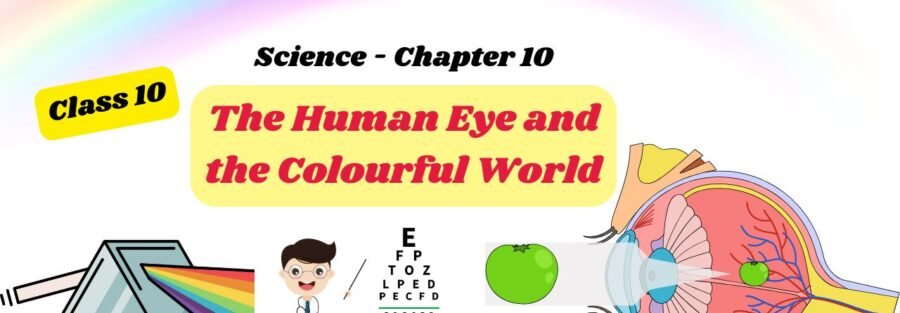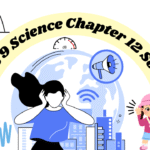The Human Eye and the Colourful World – Short Notes
1. Structure and Function of the Human Eye
Main Parts:
- Eyeball: Hard structure containing all parts of the eye.
- Iris: Coloured part that controls the amount of light entering the eye.
- Pupil: Black opening in the iris through which light enters.
- Eye lens: Acts like a convex lens, forms image on the retina.
- Ciliary muscles: Change the focal length of the eye lens (accommodation).
- Retina: Light-sensitive layer where image is formed. Contains two types of cells:
- Cones: For bright light and colour vision.
- Rods: For dim light vision.
- Optic nerve: Carries signals from retina to the brain.
2. Power of Accommodation
- The ability of the eye to focus on near and distant objects by changing the focal length of the eye lens.
- For distant objects: Ciliary muscles relax → lens becomes thin → focal length increases.
- For near objects: Ciliary muscles contract → lens becomes thick → focal length decreases.
3. Eye Defects and Their Correction
| Eye Defect | Cause | Symptoms | Correction |
|---|---|---|---|
| Myopia (Short-sightedness) | Excessive curvature of lens or elongation of eyeball | Distant objects appear blurred | Concave lens glasses |
| Hypermetropia (Long-sightedness) | Less curvature of lens or shortening of eyeball | Near objects appear blurred | Convex lens glasses |
| Presbyopia | Reduced flexibility of eye lens with age | Difficulty in seeing nearby objects | Bifocal lenses |
| Astigmatism | Irregular curvature of cornea | Blurred or distorted vision | Cylindrical lens glasses |
4. Dispersion of Light by Prism
- Dispersion: Splitting of white light into its constituent colours.
- Spectrum of white light: VIBGYOR (Violet, Indigo, Blue, Green, Yellow, Orange, Red).
- Red light has least refractive index, violet has highest.
5. Atmospheric Refraction
- Bending of light due to changing density of atmospheric layers.
- Examples:
- Twinkling of stars: Due to atmospheric refraction.
- Advanced sunrise and delayed sunset: Sun appears 2 minutes before actual sunrise and remains visible 2 minutes after sunset.
6. Scattering of Light
- Phenomenon of absorption and re-emission of light by atmospheric particles.
- Rayleigh’s scattering law: Scattering (\propto \frac{1}{\lambda^4}) (inversely proportional to fourth power of wavelength).
- Shorter wavelengths (blue/violet) scatter more.
- Longer wavelengths (red/orange) scatter less.
Daily life examples:
- Blue colour of sky: More scattering of blue light.
- Red colour of sunrise/sunset: Less scattering of red light.
- Blue colour of sea: Absorption and scattering of blue light by water.
7. Human Eye Vs. Camera
| Human Eye | Camera |
|---|---|
| Image formed on retina | Image formed on film/sensor |
| Ciliary muscles change focal length | Lens moved back-forth for focusing |
| Iris controls light amount | Diaphragm controls light amount |
Important Diagrams to Practice
- Structure of human eye
- Correction of myopia and hypermetropia
- Dispersion of light through prism
Exam Tips:
- Remember causes, symptoms and correction of eye defects.
- Understand examples of light scattering.
- Be prepared for diagram-based questions.
कक्षा 10 विज्ञान – अध्याय 11: मानव नेत्र तथा रंगबिरंगा संसार
1. मानव नेत्र की संरचना एवं कार्य
मुख्य भाग:
- नेत्र गोलक: कठोर भाग जिसमें नेत्र के सभी भाग होते हैं।
- परितारिका: रंगीन भाग, नेत्र में प्रवेश करने वाले प्रकाश की मात्रा नियंत्रित करती है।
- पुतली: परितारिका के बीच का काला छिद्र, जिससे प्रकाश अंदर प्रवेश करता है।
- नेत्र लेंस: उत्तल लेंस की तरह कार्य करता है, प्रतिबिंब रेटिना पर बनाता है।
- सिलियरी पेशियाँ: नेत्र लेंस की फोकस दूरी बदलती हैं (समंजन)।
- रेटिना: प्रकाश-संवेदी परत, जहाँ प्रतिबिंब बनता है। इसमें दो प्रकार की कोशिकाएँ होती हैं:
- शंकु: तीव्र प्रकाश एवं रंगों के लिए।
- दंड: मंद प्रकाश के लिए।
- दृष्टि तंत्रिका: रेटिना से संकेत मस्तिष्क तक पहुँचाती है।
2. नेत्र की समंजन क्षमता
- नेत्र लेंस की फोकस दूरी बदलकर निकट एवं दूर की वस्तुओं को स्पष्ट देखने की क्षमता।
- दूर की वस्तु देखने पर: सिलियरी पेशियाँ शिथिल → लेंस पतला होता है → फोकस दूरी बढ़ती है।
- निकट की वस्तु देखने पर: सिलियरी पेशियाँ सिकुड़ती हैं → लेंस मोटा होता है → फोकस दूरी घटती है।
3. नेत्र दोष एवं उनका संशोधन
| नेत्र दोष | कारण | लक्षण | संशोधन |
|---|---|---|---|
| निकटदृष्टि (मायोपिया) | नेत्र लेंस का अधिक वक्र होना या नेत्र गोलक का लंबा होना | दूर की वस्तुएँ धुँधली दिखती हैं | अवतल लेंस का चश्मा |
| दूरदृष्टि (हाइपरमेट्रोपिया) | नेत्र लेंस का कम वक्र होना या नेत्र गोलक का छोटा होना | निकट की वस्तुएँ धुँधली दिखती हैं | उत्तल लेंस का चश्मा |
| जरा दूरदृष्टि (प्रेसबायोपिया) | उम्र के साथ नेत्र लेंस की लचीलापन कम होना | निकट की वस्तुएँ स्पष्ट नहीं दिखतीं | बाइफोकल लेंस का चश्मा |
| अबिंदुकता (एस्टिग्मेटिज्म) | कॉर्निया की अनियमित वक्रता | वस्तुएँ तिरछी या धुँधली दिखती हैं | बेलनाकार लेंस का चश्मा |
4. प्रिज्म द्वारा प्रकाश का विक्षेपण
- विक्षेपण: श्वेत प्रकाश का अपने घटक रंगों में विभक्त होना।
- श्वेत प्रकाश का स्पेक्ट्रम: VIBGYOR (बैंगनी, जामुनी, नीला, हरा, पीला, नारंगी, लाल)।
- लाल light का अपवर्तनांक सबसे कम, बैंगनी का सबसे अधिक होता है।
5. वायुमंडलीय अपवर्तन
- वायुमंडल की विभिन्न परतों के घनत्व में परिवर्तन के कारण प्रकाश का मुड़ना।
- उदाहरण:
- तारों का टिमटिमाना: वायुमंडलीय अपवर्तन के कारण।
- सूर्योदय एवं सूर्यास्त: सूर्य वास्तविक स्थिति से 2 मिनट पहले दिखता है और 2 मिनट बाद तक दिखता रहता है।
6. प्रकाश का प्रकीर्णन
- वायुमंडल में उपस्थित कणों द्वारा प्रकाश के अवशोषण और पुनः उत्सर्जन की घटना।
- रेले का प्रकीर्णन नियम: प्रकीर्णन (\propto \frac{1}{\lambda^4}) (तरंगदैर्ध्य के चौथे घात के व्युत्क्रमानुपाती)।
- छोटी तरंगदैर्ध्य (नीला/बैंगनी) का प्रकीर्णन अधिक होता है।
- बड़ी तरंगदैर्ध्य (लाल/नारंगी) का प्रकीर्णन कम होता है।
दैनिक जीवन से उदाहरण:
- आकाश का नीला दिखना: नीले प्रकाश का अधिक प्रकीर्णन।
- सूर्योदय/सूर्यास्त का लाल दिखना: लाल प्रकाश का कम प्रकीर्णन।
- समुद्र का नीला दिखना: जल द्वारा नीले प्रकाश का अवशोषण एवं प्रकीर्णन।
7. मानव नेत्र Vs. कैमरा
| मानव नेत्र | कैमरा |
|---|---|
| रेटिना पर प्रतिबिंब बनता है | फिल्म/सेंसर पर प्रतिबिंब बनता है |
| सिलियरी पेशियाँ लेंस की फोकस दूरी बदलती हैं | लेंस को आगे-पीछे करके फोकस किया जाता है |
| परितारिका प्रकाश की मात्रा नियंत्रित करती है | डायाफ्राम प्रकाश की मात्रा नियंत्रित करता है |
महत्वपूर्ण आरेख
- मानव नेत्र का अनुप्रस्थ काट
- निकटदृष्टि एवं दूरदृष्टि का संशोधन
- प्रिज्म द्वारा श्वेत प्रकाश का विक्षेपण
परीक्षा सुझाव:
- नेत्र दोषों के कारण, लक्षण और संशोधन याद रखें।
- प्रकाश के प्रकीर्णन के उदाहरणों को समझें।
- आरेख सहित प्रश्नों के लिए तैयार रहें।


